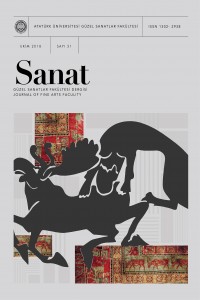Öz
There are certain internal and external influences orienting the political power that a state has for the artistic field. The most important external influence is state support in the formation of culture and art. This power affects art via economic and legal sanctions. Religious beliefs and political decisons which are the internal influences affecting the cultural and artistic policies of a country are important effective elements that are extended to quite wide areas. The creators of these decisions and norms are the groups taking port in the formation of cultural policy. The chief role among these groups and institutions belongs to the norm and decision making State. State suppors art and it is the protector of art and the artist, and by providing him with working opportunities it becomes the patron of art. During history, the states protecting the artists have always provided the important group with working opportunities by benefitng from the affectng power of the artist. Within a society, state and every religious, educational and economic institution wish to Orient art for the sake of their own needs. Religious institutions want to Orient art into the direction of their dogmas, state into serving its patrotic citizens, agreeing with its own authority, and economic institutions into profit making and they are all effective on what kind of art will be produced. If we look at the line showing the development of art in Europe from an administrative perspective, then we will see that this line started from the ourt first and then continued with the group supportng art, called culture barons. Culture barons is the nome of group who invested in art and culture and thus enabled the develepoment of art within society. The support of the clergy, the kings, the rich and the noble class has provided the art and the artist with great support. Throughtout history, art has been in close interaction with political institutions and governng bodies.
Anahtar Kelimeler
art policy goverment public support private sector individual efforts
Kaynakça
- ERBAY, Mutlu (1997). Plastik Sanatlar Eğitiminin Gelişimi. İstanbul: Boğaziçi Üniversitesi Yayınları.
- ERBAY, Mutlu (2007). Resim Sanatı Disiplinleri. İstanbul: Alternatif Yayınları.
- ERBAY, Mutlu (2013). Sanat Eğitimi Üzerine. İstanbul: BetaYayınları.
- MOODY, Eric (1992). ‘Art and Politics Museum 2000:Politics, People, Professionals and Profit’ Patrick Boylan(Ed) London: Museum Association Press.
- KONGAR, Emre (1994). Kültür Üzerine. İstanbul:Remzi Kitapevi.
Öz
Bir devletin sanat alanında sahip olduğu verileri yönlendiren iç ve dış unsurlar bulunmaktadır. Dış etkilerin başında kültür ve sanatın oluşumunda devlet desteği gelmektedir. Devletin ekonomik ve hukuksal yaptırımları sanatı etkilemektedir. Bir ülkede devletin kültür ve sanat politikasını etkileyen iç etkiler, dini inançlar ve politik kararlar, oldukça geniş alanlara yayılan önemli etki unsurlarıdır. Devletin sanat alanındaki desteği sanatın, sanatçının koruyucusu ve çalışma olanakları sağlayarak hamisi olmasıdır. Tarihsel süreç içinde, sanatçıyı koruyan devletler, onun etkileyicilik gücünden yararlanarak, bu önemli gruba her zaman çalışma alanı sağlanmıştır. Bir toplumda devlet, din, eğitim ve ekonomi kurumlarının her biri sanatı kendi ihtiyaçları acısından yönlendirmek ister. Devlet kendi otoritesiyle birleşen yurtsever vatandaşlara hizmet etmeye, ekonomi kurumları ise kar sağlamaya yönelik sanatı etkilemek isterler ve hangi tip sanatın üretileceği üzerine seçimleri ve tercihleri ile etkide bulunurlar. Avrupa’da sanatın yönetimsel açıdan gelişmesi çizgisine bakılacak olursa bu çizginin önce saraydan, sonra kültür baronları adı altında toplanan kültürü destekleyen gruptan geldiği görülecektir. Kültür baronları, sanata ve kültüre yatırım yapan ve toplumda sanatın gelişmesini sağlayan gruptur. Din adamları, krallar, zenginler sınıfı ve asillerin desteği, asırlarca sanatçıya, sanata katkı sağlamıştır. Tarih boyunca sanat, siyasi kurumlar ve yönetimsel yapı ile yakın etkileşim içinde olmuştur. Avrupa’da da sanat her dönemde, yöneticiler tarafından desteklenmiştir.
Anahtar Kelimeler
Kaynakça
- ERBAY, Mutlu (1997). Plastik Sanatlar Eğitiminin Gelişimi. İstanbul: Boğaziçi Üniversitesi Yayınları.
- ERBAY, Mutlu (2007). Resim Sanatı Disiplinleri. İstanbul: Alternatif Yayınları.
- ERBAY, Mutlu (2013). Sanat Eğitimi Üzerine. İstanbul: BetaYayınları.
- MOODY, Eric (1992). ‘Art and Politics Museum 2000:Politics, People, Professionals and Profit’ Patrick Boylan(Ed) London: Museum Association Press.
- KONGAR, Emre (1994). Kültür Üzerine. İstanbul:Remzi Kitapevi.
Ayrıntılar
| Birincil Dil | Türkçe |
|---|---|
| Bölüm | Makaleler |
| Yazarlar | |
| Yayımlanma Tarihi | 30 Ekim 2018 |
| Gönderilme Tarihi | 25 Mart 2018 |
| Yayımlandığı Sayı | Yıl 2018 Sayı: 31 |

Bu eser Creative Commons Atıf-GayriTicari 4.0 Uluslararası Lisansı ile lisanslanmıştır.


